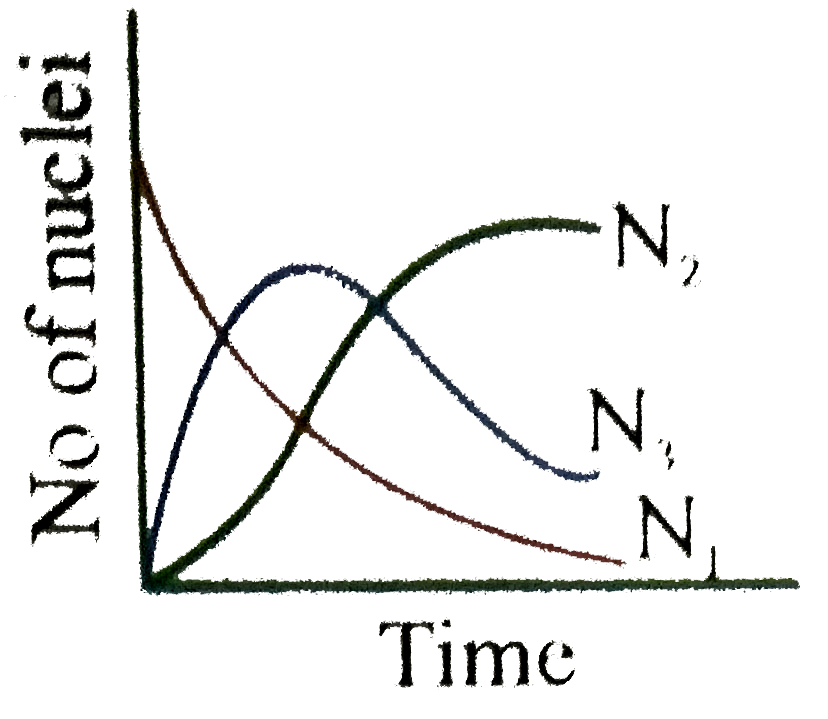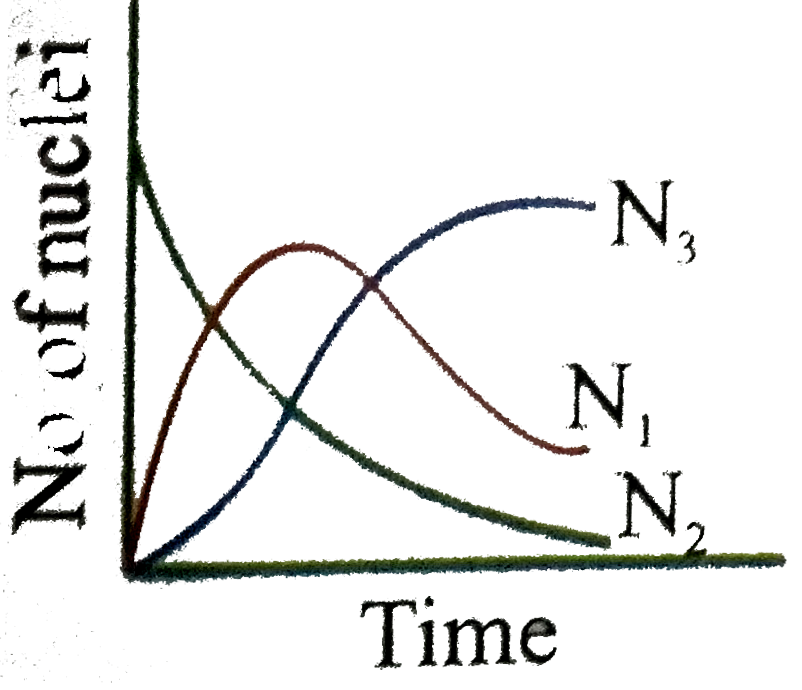Uranium .23892U is an ustable nucleus. It decays to Thorium .23892Th, which is again an unstable nucleus which further decays to .23491Pa. Let .23892U be called A of decay constant λ1 and .23490Th is called as B of decay constant λ2 and stable nuclei .23491Pa be called as C. Here A is called parent nucleus and B is called daughter nucleus of A. Any two adjacent nuclei may be consider parent or daughter nuclei A,B and C respectively at time 't'.
Then we can write Aλ1−−→Bλ2−−→C
Rate of disintergration of A=dN1dt=λ1N1
Rate of disintergration of B=dN2dt=λ1N1−λ2N2
Rate of formation of nuclei C is equal to
dN3dt=λ2N2
If at t=0, there are N0 number of nuclei of A where as nuclei B and C are absent in the sample Answer the following questions
The graph N1,N2 and N3 with time can be best represent by




The correct Answer is:B
Successive disintegration
Topper's Solved these Questions
- NUCLEAR PHYSICSBOOK - NARAYNACHAPTER - NUCLEAR PHYSICSEXERCISE - Previous JEE questions
21 Videos
- NUCLEAR PHYSICSBOOK - NARAYNACHAPTER - NUCLEAR PHYSICSEXERCISE - LEVEL-I-(H.W)
16 Videos
- NUCLEAR PHYSICSBOOK - NARAYNACHAPTER - NUCLEAR PHYSICSEXERCISE - Level-V Multiple answer questions
45 Videos
- MOVING CHARGES AND MAGNETISMBOOK - NARAYNACHAPTER - MOVING CHARGES AND MAGNETISMEXERCISE - EXERCISE - 4
20 Videos
- NUCLEI BOOK - NARAYNACHAPTER - NUCLEI EXERCISE - ASSERTION & REASON
5 Videos
Similar Questions
Uranium .23892U is an ustable nucleus. It decays to Thorium .23892Th, which is again an unstable nucleus which further decays to .23491Pa. Let .23892U be called A of decay constant λ1 and .23490Th is called as B of decay constant λ2 and stable nuclei .23491Pa be called as C. Here A is called parent nucleus and B is called daughter nucleus of A. Any two adjacent nuclei may be consider parent or daughter nuclei A,B and C respectively at time 't'.
Then we can write Aλ1−−→Bλ2−−→C
Rate of disintergration of A=dN1dt=−λ1N1
Rate of disintergration of B=dN2dt=λ1N1−λ2N2
Rate of formation of nuclei C is equal to
dN3dt=−λ2N2
If at t=0, there are N0 number of nuclei of A where as nuclei B and C are absent in the sample Answer the following questions ltbgt Numeber of the nuclei of nuclei C at time t is
View SolutionUranium .23892U is an ustable nucleus. It decays to Thorium .23892Th, which is again an unstable nucleus which further decays to .23491Pa. Let .23892U be called A of decay constant λ1 and .23490Th is called as B of decay constant λ2 and stable nuclei .23491Pa be called as C. Here A is called parent nucleus and B is called daughter nucleus of A. Any two adjacent nuclei may be consider parent or daughter nuclei A,B and C respectively at time 't'.
Then we can write Aλ1−−→Bλ2−−→C
Rate of disintergration of A=dN1dt=λ1N1
Rate of disintergration of B=dN2dt=λ1N1−λ2N2
Rate of formation of nuclei C is equal to
dN3dt=λ2N2
If at t=0, there are N0 number of nuclei of A where as nuclei B and C are absent in the sample Answer the following questions
Number of nuclei of B at any time t is
View Solution
Knowledge Check
Uranium .23892U is an ustable nucleus. It decays to Thorium .23892Th, which is again an unstable nucleus which further decays to .23491Pa. Let .23892U be called A of decay constant λ1 and .23490Th is called as B of decay constant λ2 and stable nuclei .23491Pa be called as C. Here A is called parent nucleus and B is called daughter nucleus of A. Any two adjacent nuclei may be consider parent or daughter nuclei A,B and C respectively at time 't'.
Then we can write Aλ1−−→Bλ2−−→C
Rate of disintergration of A=dN1dt=λ1N1
Rate of disintergration of B=dN2dt=λ1N1−λ2N2
Rate of formation of nuclei C is equal to
dN3dt=λ2N2
If at t=0, there are N0 number of nuclei of A where as nuclei B and C are absent in the sample Answer the following questions ltbgt Numeber of the nuclei of nuclei C at time t isAN0[1+λ1λ2−λ1e−λ2t−λ2λ2−λ1e−λ1t]BN0[λ1λ2−λ1e−λ2t−λ2λ2−λ1e−λ1t]CN0λ1λ2−λ1(e−λ2t−e−λ1t)DN0[λ1λ2−λ1e−λ2t−λ2λ2−λ1e−λ1t−1]Uranium .23892U is an ustable nucleus. It decays to Thorium .23892Th, which is again an unstable nucleus which further decays to .23491Pa. Let .23892U be called A of decay constant λ1 and .23490Th is called as B of decay constant λ2 and stable nuclei .23491Pa be called as C. Here A is called parent nucleus and B is called daughter nucleus of A. Any two adjacent nuclei may be consider parent or daughter nuclei A,B and C respectively at time 't'.
Then we can write Aλ1−−→Bλ2−−→C
Rate of disintergration of A=dN1dt=λ1N1
Rate of disintergration of B=dN2dt=λ1N1−λ2N2
Rate of formation of nuclei C is equal to
dN3dt=λ2N2
If at t=0, there are N0 number of nuclei of A where as nuclei B and C are absent in the sample Answer the following questions
Number of nuclei of B at any time t isAN0λ1λ2−λ1(eλ1t−eλ2t)BN0λ1λ2−λ1(e−λ1t−e−λ2t)CN0λ1λ2−λ1(e−λ1t−e−λ2t)DN0λ2λ2−λ1(e−λ1t+e−λ2t)Alpha decay of .23892U forms .23490Th. What kind of decay from .23490Th produces .23484Ac ?
AαBβCβ+(positron)Dγ -emission
Uranium 23892U is an unstable nucleaus. It decays to Thorium 23490Th, which is again an unstable nuclei which further decays to 23491Pa. Such decay is called successive dlsntegration. Let 23892U is called as A of decay constant λ1 and 23490Th is called as B of decay constant λ2 and stable nuclei 23491Pa is named as C. Here A is called parent nucleus and B is called daughter nucleus of A. Any two adjacent nuclei may be consider parem daughter nuclei. Suppose N1, N2 and N3 are number of nuclei A, B and C respectively at time t which undergoes decay. Then we can write
Aλ2−−→Bλ2−−→C
Rate of disintegration of A=dN1dt=−λ1N1
Rate of disintegration of B=−λ2N2 and net rate of formation of B=dN2dt=λ1N1−λ2N2
Rate of formation of nuclei C is equal to dN3dt=λ2N2
If at t=0, there are N0 number of nuclei of A, where as nuclei B and C are absent in the sample answer the following questions
The graph between N1, N2 & N3 with time can be best represented by
View SolutionAlpha decay of .23892U forms .23490Th. What kind of decay from .23490Th produces .23484Ac ?
View Solution.23892U has 92 protons and 238 nucleons. It decays by emitting an alpha particle and becomes:
View Solution23491Pa→23492U occurs with the emission of
View Solution.234U has 92 protons and 234 nucleons total in tis nucleus. It decays by emitting an alpha particle. After the decay it becomes:
View Solution
